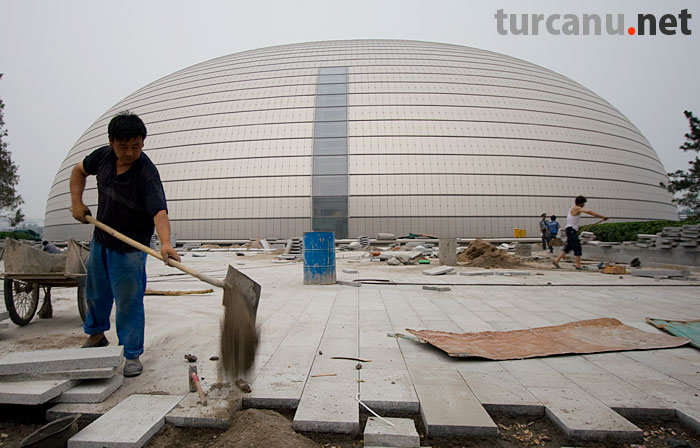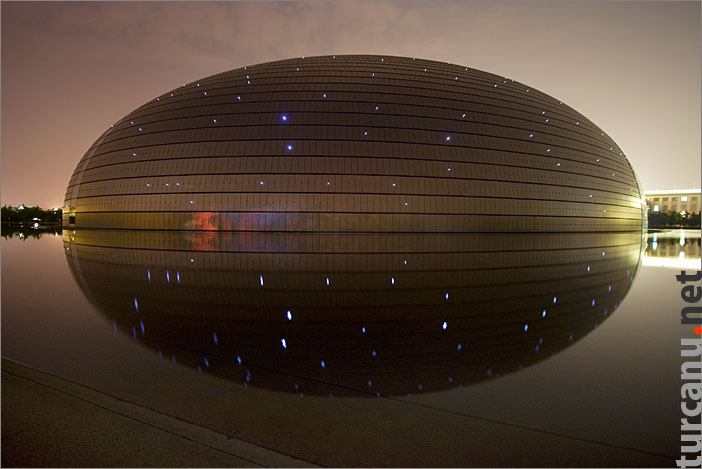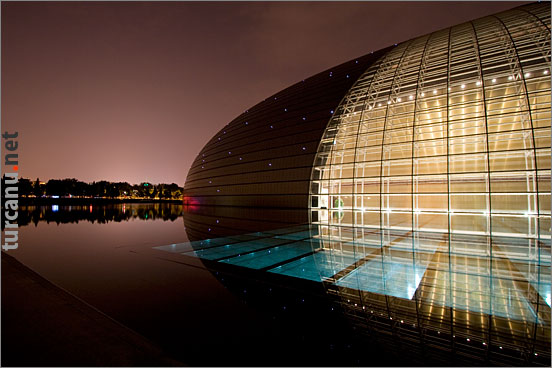National Grand Theater of China which is sometimes referred to as Beijing Opera House, but is nicknamed “The Egg” is actually officially called – National Centre for Performing Arts (国家大剧院). It is one of the new landmarks of the city which is located in the very heart of it, right next to Great Hall of the People in Tian An Men Square. What makes it apart is the unusual architecture that looks like an egg. The building is surrounded by an artificial lake and when looking at it and it’s reflection it forms the shape of an egg. It is especially beautiful in the evening when it’s titanium and glass dome is sparkling lights.

First time I saw this ellipsoidal construction being built in the heart of Beijing, I assumed they are building a sports arena, a stadium of some kind. But of course I was wrong, it was the Opera House as I’ve been told. In December 2007, after 6 years since the beginning of construction, the first concert was held and “The Egg” became part the Chinese capital city.

Even back then, when it was still under construction, I remember locals were quite unhappy about this new modern building and the main reason was that it spoils the view. When viewing the Forbidden City from the Coal Hill (Jingshan Hill, 景山) the new construction appears to be not in harmony with the general view they said. Also it spoils the feng shui of the area they mentioned, the shape is wrong, the location is not good and when practicing tai chi in Beihai Park you can see the egg-shaped dome they complained. I don’t know much about feng shui, but it does look a bit out of place to me as well. Although it is a brilliant construction and is an amazing piece of architecture.
Speaking of architecture, it will for sure be considered as one of the new symbols of Beijing, maybe not quite the same as the Sydney Opera House, but rather as a link between modern and ancient. The architect of this project is Paul Andreu, the renowned French architect who also designed Shanghai Pudong Airport and numerous other big constructions around China. The total area of the Grand Theater is 200,000 square meters and it can accommodate 6500 people. The maximum ellipsoid span is 213 meters, minimum being 144 meters and the height reaches just 46 meters. The Centre of Performing Arts is composed of three main halls inside, each designed for the particular use: The Opera Hall (opera’s, ballet, dances), The Music Hall (musical performances) and The Theater Hall (theatrical plays and Chinese opera’s).
As everything else built in China recently building this grandiose performing arts centre involved high costs – 3.2 billion RMB, which is about 320 Million Euro today. That means the average cost for one seat is about half a million RMB (50,000 Euro) and it is clear that it will take tens of years before any profits will be made, when looking at cheap tickets prices offered to the public (starting at 10 RMB).

If you’re in Beijing for sightseeing and do not feel like spending the evening in your hotel, if you don’t feel like exploring the Sanlitun bars either, I would suggest you make an evening trip to Tian An Men square: take a few pictures in front of Mao’s portrait at the gates of the Forbidden City, head towards The Museum of Chinese History (East side), see if the main Olympic countdown digital display is still there, go around Chairman Mao’s Memorial Hall and behind Great Hall of People to The National Grand Theater. It will be a nice night walk, just make sure you start your trip earlier (depending how much time you need) because at 12:00 PM all the lights on the surrounding buildings will be turned off, some even earlier at 11:00 or 11:30 PM. You might also consider a trip to Qianmen Gate which is nicely lit in the evening and was resaturated recently, also the Qianmen street for tourists will be open soon in the same area.


wow . that is a beautiful theater . we dont have such fantastic looking theaters in our country . its really worth seeing .
this article was quite usefull to me, and my english was poor, but i know most part of it. especially when you mentioned about Chinese Fengshui. and as i know most of the Chinese people do believe this, when you do some construction work, you must know the Fengshui well. the good builing that construct in the right place can bring you with good fortune, otherwise thy will bring you bad luck. so lots of the citizens think that the grand national theater has not only spoil the senecry but also the good luck. it is really a waste of money since there’s already lots of theaters in Beijing.